Every successful event starts from well-defined business goals.
That’s why before diving straight into the event planning, you should make sure to have your desired outcome laid out and then create your whole event strategy around it.
So, as a starter, always keep this in mind:
Your event strategy and business goals go hand in hand, and your event strategy is a reflection of the latter.
That being said, there’s one crucial element every event professional knows well. No matter the type of event and the ultimate goals, facilitating attendee networking should always be among your top priorities.
In fact, participants attend your events for many reasons, but networking still ranks in the top three (with 76% of attendees naming networking as their top reason to attend).
This doesn’t come as a surprise, as networking brings a host of benefits. To name a few:
- Better business connections,
- Higher visibility,
- More sales,
- Fresh ideas and deeper knowledge,
- Career advancement opportunities,
- And last but surely not least: greater satisfaction at events.
And to help you strengthen your event networking experiences, we recently launched a complete training course that will explain everything you need to know about matchmaking and networking (including the metrics). Enroll for free and become matchmaking certified 🤝
How can the right event networking metrics help you succeed?
Successful intent-based networking can help...
- conferences attract more sponsors,
- connect association members or employees at internal events,
- grow a network of experts at academic events,
And much more!
Yet, in an industry where you often only have one chance to get it right, it would be unthinkable to go with your guts and not base your decisions on quantifiable indicators. Event networking metrics will help you assess your networking strategy and quantify your success.
Tracking the right event networking metrics will also bring you:
- Higher audience engagement and CSAT: tracking the right metrics will allow you to pinpoint your attendees’ interests and main reasons to attend, beyond identifying the trending topics. This way you'll be able to fine-tune your content to your audience’s needs and make sure there’s not a doubt left as to why they should attend your event. It was tailored for them after all! Also, a happier audience equals higher CSAT (and better word of mouth).
- Better sponsorship packages: sponsors decide to partner with you because they understand your event will profit them in terms of new deals and connections with qualified leads. The right event metrics will help you prove your ROI possibilities and how you can help your sponsors get more visibility.
- Higher sponsors and ticket retention: what happens when your attendees and sponsors have reached their goals and enjoyed their experience to the fullest? They come back for more and recommend your events to others. At Brella, we’ve observed that intent-based networking alone can improve your ticket retention by 18%.

Event hosting platforms are a goldmine for valuable event stats and numbers, and there are many options you can choose from (take a look at our master list of essential features your event platform needs). When choosing your event hosting platform or networking tool always make sure to pay close attention to what event networking metrics you’ll have access to and how reliable they are.
Now, let’s move on to the 10 must-track event networking metrics that will help you measure and perfect your networking strategy.

To learn more about the essential networking metrics, enroll in our free course today at the Brella Academy!
Event networking metrics you should track
Here are the top event networking metrics you have to track in order to measure your networking strategy and quantify your success or adjust your approach.
We have grouped them into meeting metrics, event matchmaking metrics, and engagement metrics.
Meeting metrics
1. Number of meetings
This first event networking metric is the obvious one - more meetings means more people network. It’s a good metric, and it goes without saying the higher the number of meetings, the greater the networking.
However, don’t let this figure deceive you as the number of meetings is not as important as their quality. For instance, only think about a business representative on the lookout for new clients who gets 20 meetings but none of those is with a relevant buyer. The number of meetings is high, but the quality could definitely be improved.
For this, there are more event networking metrics that can help you assess the quality of the meetings.
2. Users with meetings
This event networking metrics tells you the number of users with meetings.
90% of the users joining your platform have booked meetings? Congratulations on a fantastic achievement! 30% of the users joining your platform have booked meetings? You should dive deeper into your networking strategy to understand what could be improved. For instance, could you optimize and update the categories for intent-based networking to better fit your audience? Should you invest more time in promoting your event platform before the event?
Planning successful events is exciting but it can easily turn into a real headache. Plus, we all could use some extra support when the stakes are so high. That’s why Brella offers a full service including event success and consulting. Our customer success managers will work with you to identify your main goal and help you achieve them by crafting a unique event strategy tailored to your event.
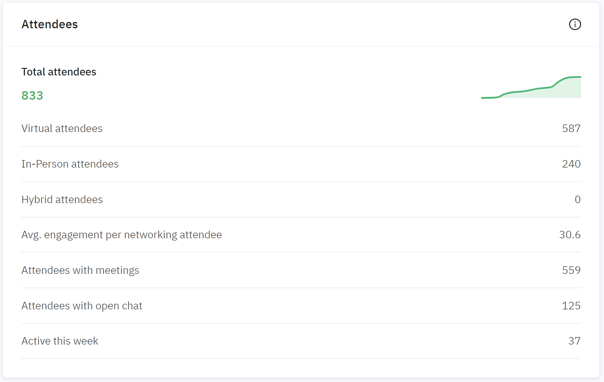
Brella's event platform gives you a detailed breakdown of attendee & networking engagement.
Also, remember that an essential part of your event strategy is also promoting your event hosting platform and educating your audience (and sponsors) on intent-based networking and how to get the most out of it. The more users join the event platform, the more meetings and networking opportunities they’ll get.
3. Number of meetings per attendee
To estimate the number of meetings per attendee, use this simple formula:
Networking meetings / Total amount of attendees
For instance, if you have 100 attendees, and you organize 150 meetings in total, that equals 1.5 meetings per user. Generally, anything around 1 is great. Having even one valuable meeting can boost satisfaction and generate great returns for your attendees.
However, why not shoot for the stars since we’re at it? Here’s a question for you: how do you boost the number of meetings while also making sure those meetings matter?
Keep on reading!
Event matchmaking metrics
When it comes to improving the quality of meetings, intent-based matchmaking is the answer.
In order to track these event networking metrics, you first need to equip yourself with a networking tool (or app).
The process is really simple: your attendees join the networking tool, create their user profile, and select their interests (e.g. entrepreneurship, marketing & advertising, software engineering) and networking intent (e.g. investment, recruiting, trading). The matchmaking feature handles the rest by analyzing thousands of data points and connecting the top matches in a matter of seconds.
So, what are the metrics you should always track for a winning matchmaking strategy?
4. Interests
Matchmaking starts with defining attendees' interests.
For instance, creating a broad category named Technologies doesn't help you guarantee top matches. Your attendees join your event because they're in the field of technologies, but they might have different interests, to name a few: cybersecurity, EdTech, SaaS, or UX & UI design.
Tracking your attendees' interests will allow you to assess the top-trending subjects and offer relevant options to choose from.
Connecting the right people starts from selecting the proper categories and interests, and we know it's not an easy task. That's why we have created a free masterclass on Event Matchmaking & Networking where you'll learn everything about successful matchmaking-driven networking.
5. Intent data
Effective networking is all about meaningful connection, and this event networking metric tells you exactly what your attendees' networking goals are.
Let's say you create a category named Technologies and a good percentage of your attendees select SaaS as an interest. There's one more step left to unleash the full power of matchmaking and that is defining your users' intent.
Intent is the ultimate goal for joining your networking tool, in other words: what are your attendees trying to achieve? After analyzing networking results from thousands of events, we found that the most common attendee goals revolved around:
- recruitment,
- investment, and
- trading.
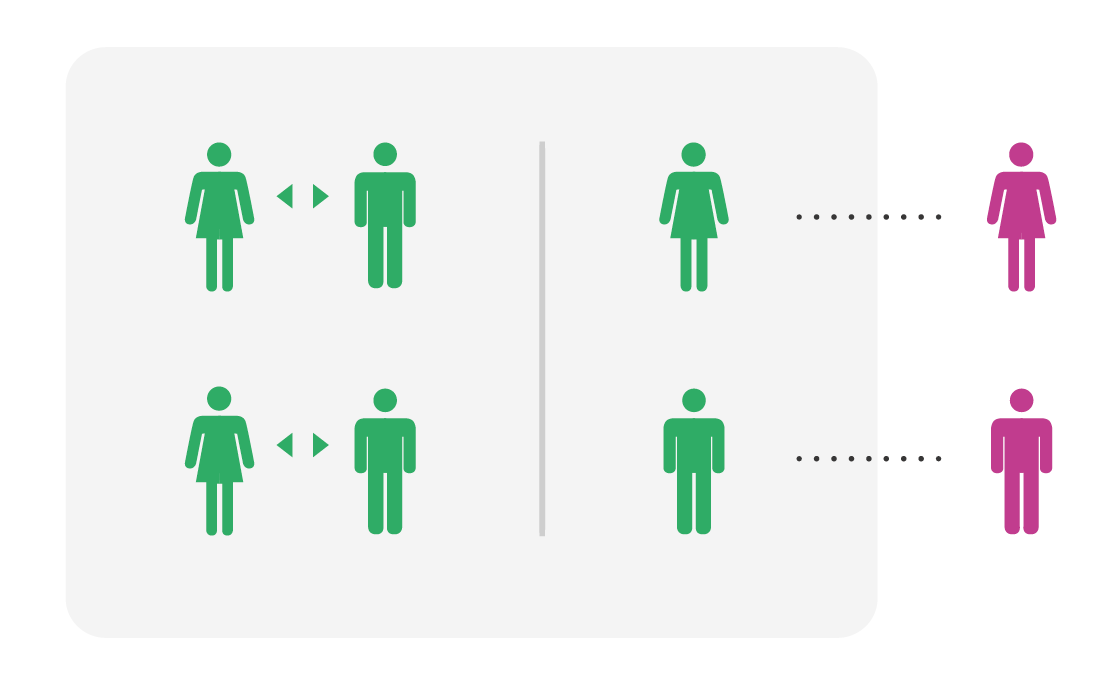
All in all, tracking interests and intent data will allow you to perfect your matchmaking strategy, maximize networking, and it will give you a great competitive advantage over competitors who don't offer any matchmaking tool.
Plus, it will give you valuable insights into what your audience is looking for, which will allow you to fine-tune your event strategy.
Let’s go back to the previous example of the business representative with 20 irrelevant meetings. What if we decrease the number to 10, but we make sure those 10 meetings are with top-relevant buyers in search of that particular solution?
Now you can see how intent-based matchmaking alone can boost meeting quality through the roof!
6. Meeting requests
If you use a networking tool to automate your networking, your attendees can find their suitable matches and send them a meeting request. Understanding how many meeting requests were sent - and how many were accepted - can provide great insights.
For example, if many meeting requests are accepted (meaning the difference between the meeting requests and actual meetings is low), then that can mean your attendees are engaged and use your tool actively.
However, if the opposite is true, it may mean that your attendees aren't engaging with your chosen tool and you should change your strategy.
It's always good to keep an eye on these numbers especially as your event approaches.
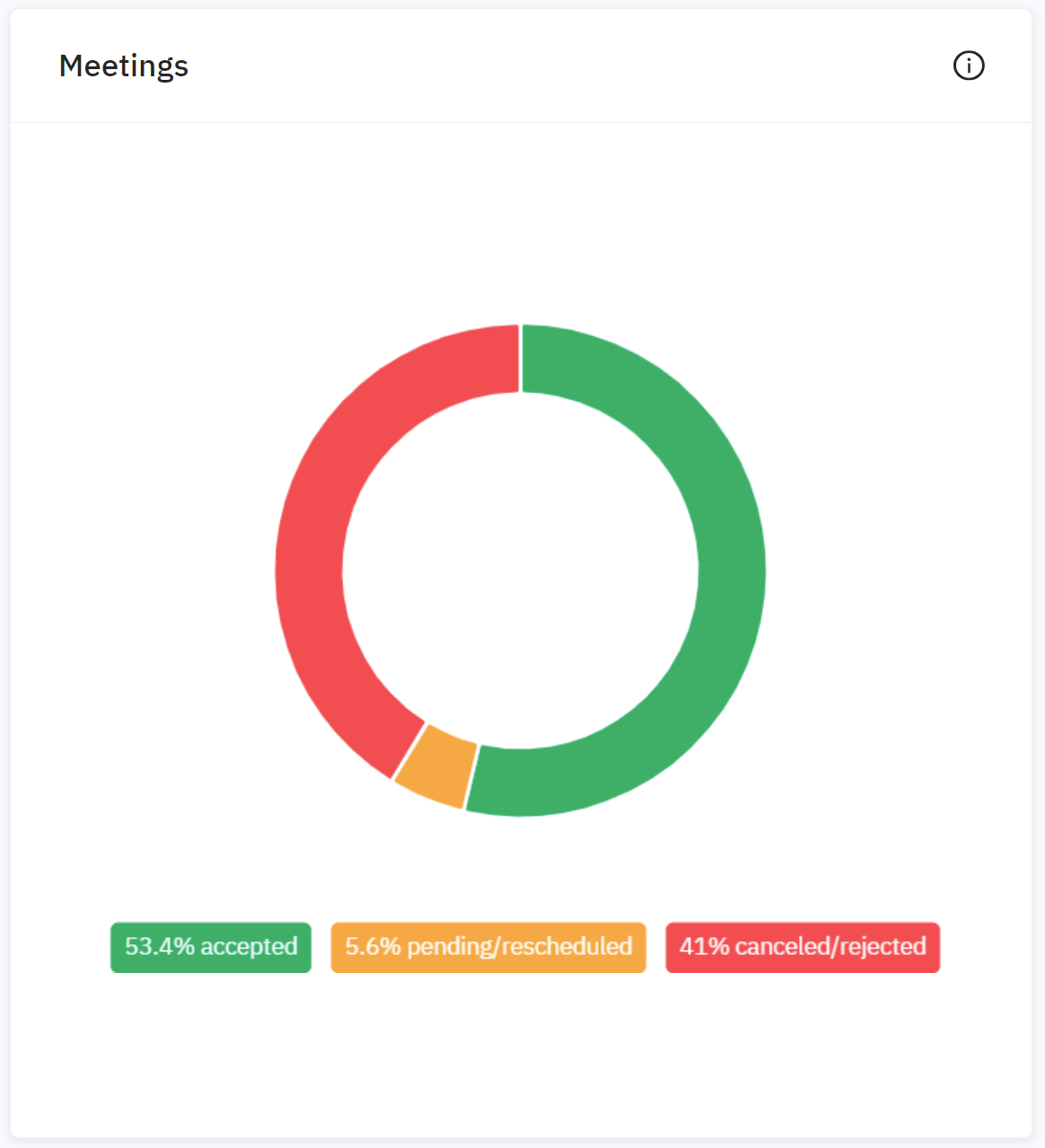
Inside Brella, you can instantly see the status of attendee meetings.
Engagement metrics
Engagement is the Holy Grail of the event industry, and for good reason.
Any up-to-speed event planner knows that long gone are the days where you could plan some speaker sessions, throw in a couple of coffee breaks, and call it a day. Your attendees' expectations have evolved and you should do your best to adapt your event strategy to meet them - and why not, exceed them.
But what do we mean by engagement?
Engagement happens when attendees turn from simple spectators into actors, most importantly, when they get to network, make new relevant connections, and reach their business goals.
Why does audience engagement matter?
- Engaged attendees get more out of the event, which brings higher satisfaction ratings and more recommendations. Also, happy attendees are more likely to return for more.
- Engaged attendees are more likely to share content on social platforms driving more visibility to your event.
- Attendee engagement has become the new industry standard. Participants’ expectations have evolved, and event organizers should be able to adapt and reinvent their strategies to stay afloat in one of the most competitive industries of our time.
Engagement metrics give deeper insight into your attendees’ activities with your event networking tool.
7. Chat messages
Networking can - and should - start long before the day of the event.
Attendee pre-engagement is crucial, and a live chat is the best way of facilitating virtual interactions before the event. That’s why the total number of chat messages exchanged is one of the top event networking metrics you should monitor.
Bonus tip: with Brella you can open the live chat feature two weeks before the event to foster pre-engagement. This way your attendees will have enough time to get to know each other and their respective businesses. Moreover, they will already be prepared on the day of the actual meeting, which leads to better 1:1 meetings.
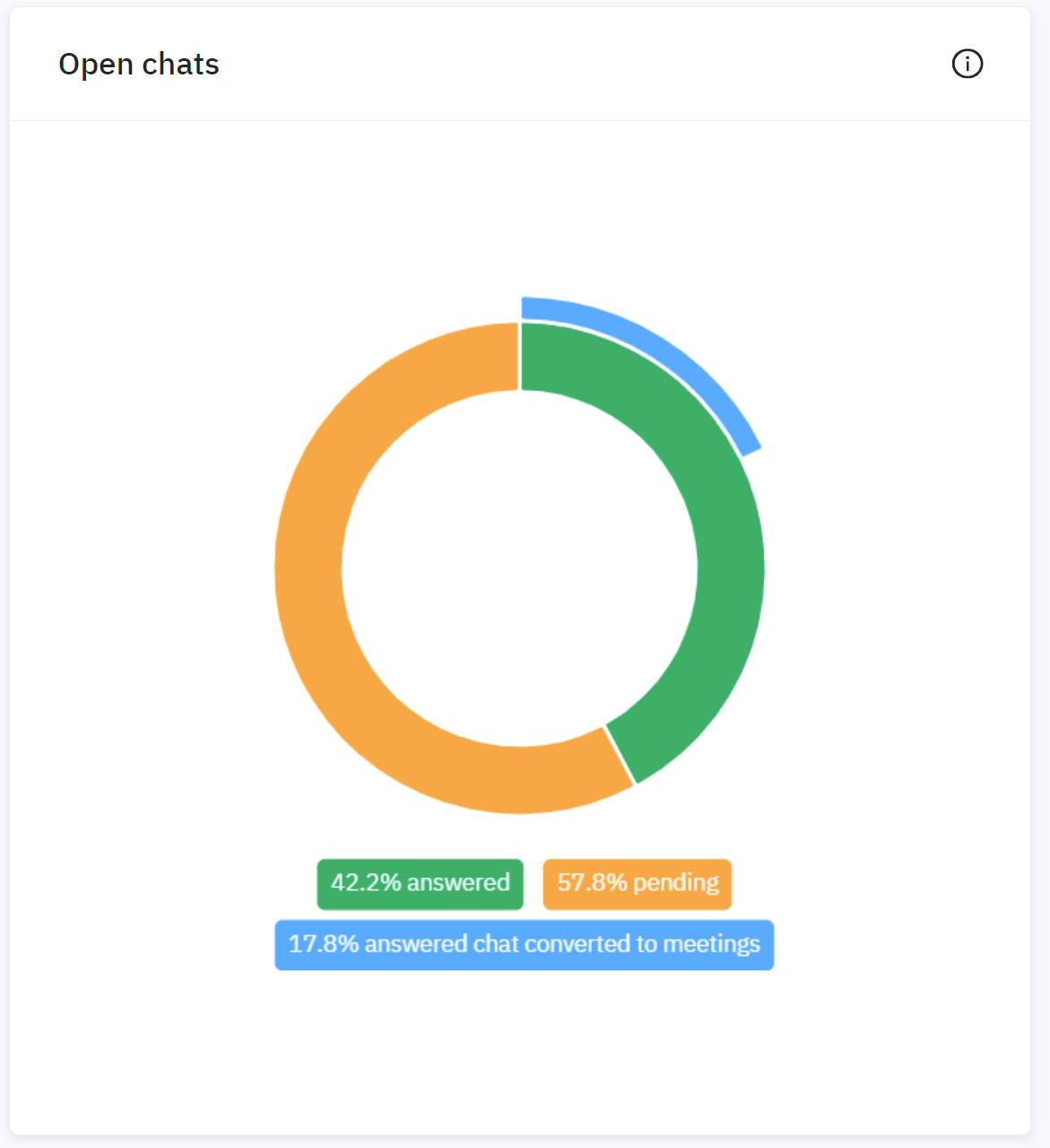
To take your measurements to the next level, use Brella to measure how many of your attendee chats convert to 1:1 meetings.
8. Average engagement per user
This event networking metric takes many different data into account (like the number of accepted meetings, meeting requests, chat messages, and more) and puts it all together to give you an idea of how engaged each user is. The higher the number, the more engaged users are.
Typically, we found that 13 is an average across our extensive portfolio of events. So, if your average engagement per user is 13 or more, this means your engagement strategy has paid off.
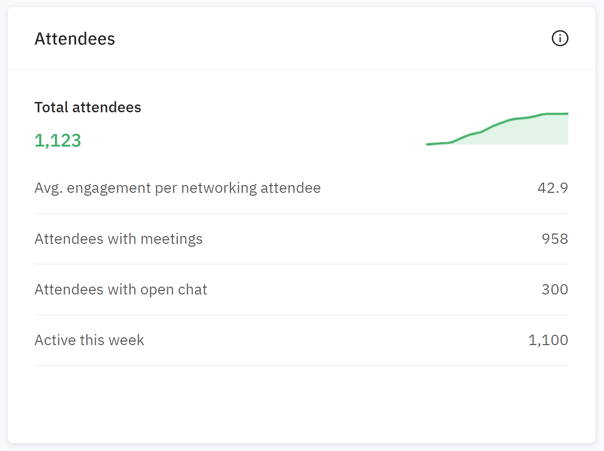
9. Engagement before event
Or pre-engagement. This event networking metric shows you how active your attendees were before the event, within your platform.
A common trend is more engagement before the event, with a spike beginning anywhere from 1 day to 1 week before the event.
If your pre-engagement rate is high, that means you did an excellent job in marketing your event networking tool and providing your attendees with enough educational material on why to join the networking tool and how to get the most out of it.
.png?width=600&name=Pre-engagement%20(1).png)
10. Engagement during event
This last event networking metric shows you how your attendees use your platform during the event, like app downloads, meeting requests, chat messages, and more.
Combining the engagement before the event and engagement during the event can tell you how well you promoted your networking tool.
Once more, engaged attendees are happy attendees, which equals higher CSAT, great word of mouth, and higher ticket retention. So, boost those numbers!
Conclusion
Networking ranks in the top three reasons to attend, and you should always plan your event strategy with this in mind.
Tracking the right networking metrics will help you assess your networking strategy and quantify your success. And once you perfect your event networking strategy you will unlock plenty of other benefits, like higher ticket retention and CSAT, more sponsorship deals, and better audience engagement.
The top 10 event networking metrics you should always track are:
- Users with meetings
- Numbers of meetings
- Numbers of meetings per attendee
- Interests
- Intent data
- Chat messages
- Average engagement per user
- Engagement before the event
- Engagement during the event
Your event hosting platform is your main source of event networking metrics. That's why you must always pay close attention to what event networking metrics you’ll have access to and how reliable they are.
Brella gives you access to plenty of event networking metrics and many more key insights that help you analyze your performance and step up your event strategy like never before.
And there's more!
As leaders in the market of event matchmaking and networking, we have distilled our expertise in a comprehensive certification course on Event Matchmaking & Networking now available for free at our own Brella Academy.
In this masterclass, you'll get to steal our own repeatable strategies for any type of event while learning everything about successful matchmaking-driven networking!
Register at Brella Academy by clicking the button below and don't forget to share your certificate with us!
Read more
- Virtual events
- Hybrid events
- In-person events
- Event sponsorship
- Event engagement
- Event matchmaking
-
Brella news
-
Brella and Swoogo Partner for Optimized Event Experiences
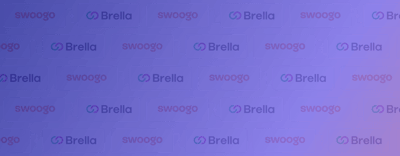
-
Brella wins the Best Event App in the US & Canada

- START Global partners with Brella for a world-class networking experience
- Brella co-hosts The European Startup Conference to help Ukrainian tech ecosystem
- Next Block Expo partners with Brella for a world-class networking experience
-
- Meet a Brellaneer

.jpg?width=2000&name=TechBBQ%20-%20Mixed%20(7).jpg)















